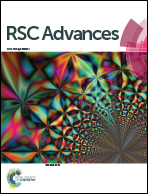Mercuration of apo-α-lactalbumin: binding of Hg2+ followed by protein-mediated nanoparticle formation†
Abstract
Nanoparticles and nanocrystals of mercury are formed when Hg2+ salt reacts with apo-α-lactalbumin (apo-α-LA). Reduction followed by nanoparticle formation is further augmented by the protein, as it also acts as a coating agent. The initial interaction of Hg2+ with apo-α-LA was demonstrated by changes observed in absorption, emission, and CD spectroscopy, where the latter technique also detected structural changes in the protein. Such structural changes are expected when Hg2+ binds to the protein, and therefore, the binding was determined by isothermal titration calorimetry (ITC). The binding was further proven by MALDI, which showed mercurated species of protein with a Gaussian distribution exhibiting a weighted average of 6 and 9 Hg2+ ions bound to protein when apo-α-LA was treated with 10 and 100 equivalents, respectively. The molecular dynamics studies revealed the binding of Hg2+ ions followed by the structural changes that occurred in the protein. The reaction between Hg2+ and apo-α-LA yields non-crystalline nanoparticles at lower molar ratios of Hg2+ and crystalline ones at higher molar ratios. The existence of both of these nanoparticles was proven by extensive TEM studies, and the mercury nanocrystals were further studied using fluorescence microscopy. X-ray photoelectron spectroscopy demonstrated that the protein has the ability to convert Hg2+ to Hg0, and the resultant Hg0 cluster is known to be less harmful than Hg2+ to the organism. All of these studies support the use of apo-α-LA in the form of nanoparticles and nanocrystals to detoxify Hg2+.


 Please wait while we load your content...
Please wait while we load your content...